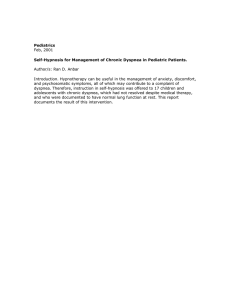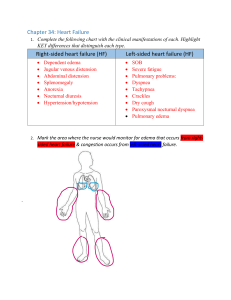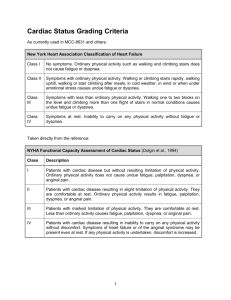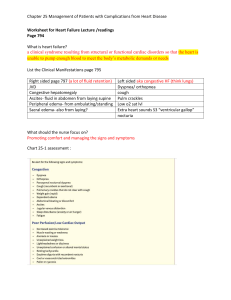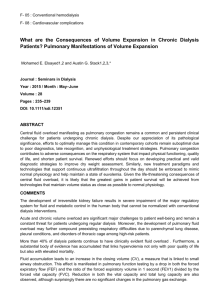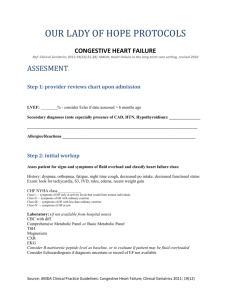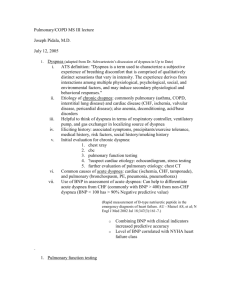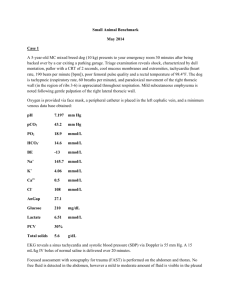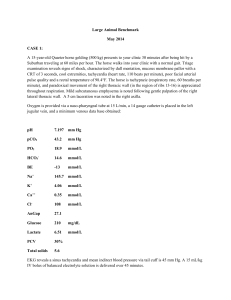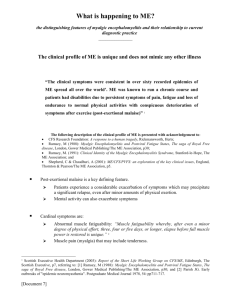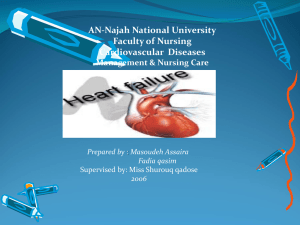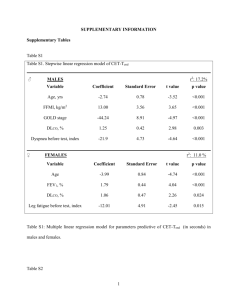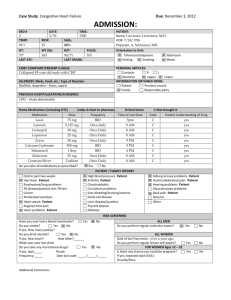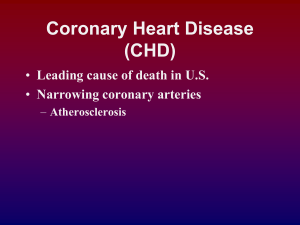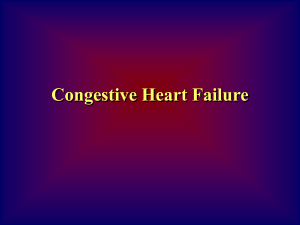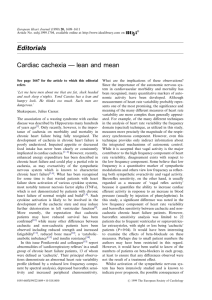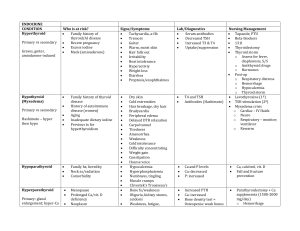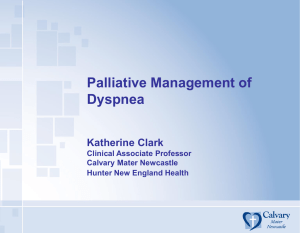CHF J Burgess 2012
advertisement
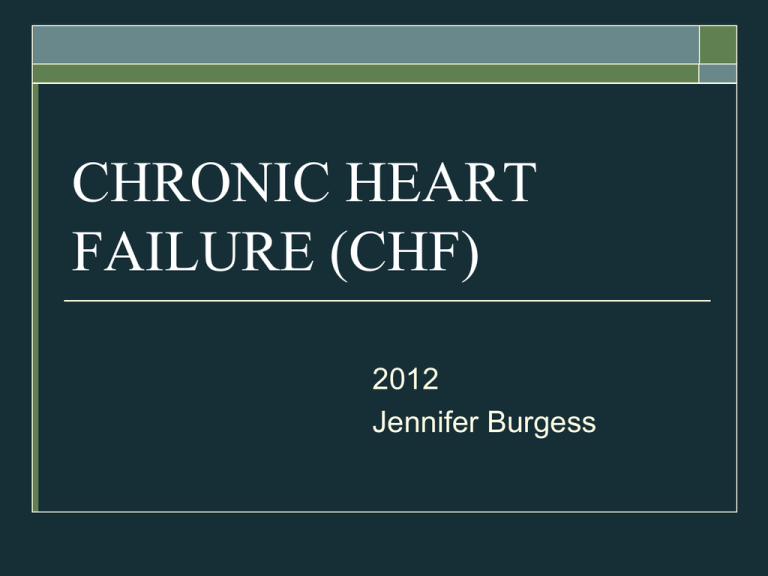
CHRONIC HEART FAILURE (CHF) 2012 Jennifer Burgess Some Facts Fastest rising cardiovascular condition in Canada affects 1 – 2% of the population (>350,000) 1.4 million hospital days per year Up to $2.3 billion per year Prevalence tripled over past decade Increasing numbers of elderly Improved survival rates of cardiac and other chronic conditions Some Facts Cannot be “Cured” by relieving symptoms Often progresses without signs or symptoms Changes occur that lead to chronic debility 33% mortality within first year of diagnosis 50% mortality within five years 3:1 males:females Heart Failure – What is it? Inability of the heart to supply sufficient blood flow to meet the body's needs Results from any heart problem that impairs ability of ventricle to fill with or eject blood Therefore not enough oxygen and nutrients supplied Can lead to fluid overload Due to low cardiac output (“Congestive” HF) or increased needs (“high output” HF) – now referred to as Heart Failure (HF) Can be acute or chronic (or acute on chronic) Can be left sided, right sided, or both (L leads to R) It is not a heart attack, or cardiac arrest What is Heart Failure? Causes Congestive heart failure can be caused by diseases that: cause stiffening, or weakening of, the heart muscle e.g.. MI, HTN increase oxygen demand by the body tissue beyond the capability of the heart to deliver. Main Risk Factors Ischemic heart disease/MI (62%) Smoking (16%) Hypertension (10%) Obesity (8%) Diabetes (3%) Valvular heart disease (2%, higher in elderly) The heart Classic Indicators of CHF Shortness of Breath Wet sounding chest due to excess fluid in and around the lungs Coughing Significant swelling in lower legs or abdomen Fatigue Signs And Symptoms LEFT HEART FAILURE RIGHT HEART FAILURE (LOW OUTPUT/PULMONARY CONGESTION) Dyspnea Orthopnea Paroxysmal nocturnal dyspnea (PND) Fatigue* Reduced exercise tolerance* Cough Confusion (Especially in elderly)* (SYSTEMIC VENOUS CONGESTION) * May be earliest presentation Peripheral edema Weight gain Anorexia Abdominal discomfort Fatigue* Reduced exercise tolerance* Additional Signs & Symptoms RR (>20) and effort Low blood pressure (<90mmHg) Heart rate > 100 Lung crackles (+/- wheeze) Elevated JVP Heart murmur Pleural effusion Cyanosis (late sign) Assessing JVP and abdominal jugular reflex Atypical Features in Frail Elderly Delirium Falls Malnutrition Sudden functional decline Sleep disturbances Nocturia or nighttime incontinence NOTE: Dyspnea and/or crackles +/- present Diagnosing HF Chest x-ray ECG Bloodwork, +/- BNP (cardiac vs pulmonary) Echocardiogram +/- angiography, nuclear imaging, MRI Differential Diagnosis Heart – valvular, CAD Renal failure with volume overload Lung disease Liver cirrhosis Obesity Deconditioning Anemia New York Heart Association Classification (NYHA) Class l (Mild) No limitation of physical activity Class ll (Mild) Slight limitation of physical activity Class lll (Moderate) Marked limitation of physical activity Class lV (Severe) Unable to carry out any physical activity without discomfort Medications ACE Inhibitors Ramipril, etc. Improve hearts pumping action Prevent disease from getting worse S/E: decreased renal function, hypotension, dizziness, cough Beta Blockers Metoprolol, etc. Reduce heart rate and work of heart Prevent and treat irregular heart beat Prevent disease from getting worse S/E: may make HF worse for first few months, bradycardia, bronchospasm, fatigue, dizziness Medications Diuretics Lasix, etc. Improve symptoms by relieving fluid overload S/E: Hypokalemia, dehydration, weakness, muscle cramps. Others ARB’s, Digoxin, Nitrates, anticoagulants, Aspirin, etc. Management Decrease sodium Na+ not efficiently excreted in HF We need 500 mg/day, we consume 5-6- gm/day Aim for 2 – 3 gm/day if stable 1 – 2 gm/day if advanced HF and fluid retention Fluid restriction 1.5 – 2 L/day if fluid retention, or if renal dysfunction or hyponatremia 1 – 1.5 L/day if severe edema Management Daily weight log when Class lll/lV or med changes after emptying bladder, before eating, same clothes, same scale Report weight when 2.5 kg increase in a week, or 2 kg in 2 days Physical activity Consider when stable and not fluid overloaded Individualized – up to, but just short of, significant Sx’s Prevention BP goal <140/90 <130/80 if DM +/or chronic kiney disease Correct anemia Medications – proper use of recommended meds can drastically reduce morbidity and mortality. E.g. ACE–I use decreases death or new HF by 29% (SOLVD Prevention study) Acute Decompensated HF (ADHF) Presentation: Dyspnea - 89% Crackles - 68% Peripheral edema - 66% SBP <90 MMHG - 3% These residents may need immediate hospitalization for I.V. diuretics, etc. End of Life Care Consider in residents who have advanced, persistent HF with symptoms at rest despite optimal pharmacological and nonpharmacological therapy: Three or more hospitalizations per year Chronic poor quality of life – unable to do ADL’s Need for IV support Needing assistive devices for breathing etc. (2006 HFSA Comprehensive HF Practice Guideline) The Good News We can help our residents who have Heart Failure to have maximal quality and quantity of life by helping them to optimally manage their disease! References Aronow, W. (2004). Evidence for the Use of Beta-blockers in Congestive Heart Failure Treatment in Older Persons. Geriatrics & Aging. 7(2), 28-32. Canadian Cardiovascular Society. (2009). Pocket reference card: Is it Heart Failure and What should I do? Retrieved from: http://www.hfcc.ca/downloads/educational_tools/pocket_card /pocket_card.html Canadian Heart Failure Network. (2009). Running a Heart Failure Clinic. Retrieved from http: //www.chfn.ca/ on May 18, 2010. References Con’t Heart Failure Society of America. (2006). 2006 HFSA Comprehensive Heart Failure Practice Guideline: Key Recommendations. Retrieved from: http://www.heartfailureguideline.org/index.cfm?id=150&s=1 Howlett, J.G., McKelvie, R.S., Arnold, J.M.O., et al. Canadian Cardiovascular Society Consensus Conference guidelines on heart failure, update 2009: Diagnosis and management of right sided heart failure, myocarditis, device therapy and recent important clinical trials. Can J Cardiol, 25(2), 85-105. Kostuk, W. (2004). Initial Evaluation of the Older Patient with Suspected Heart Failure. Geriatrics & Aging, 7(2), 13-16.
